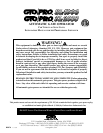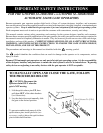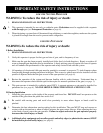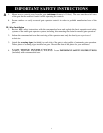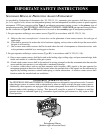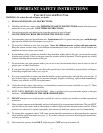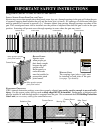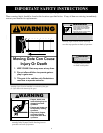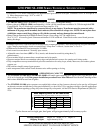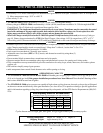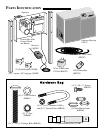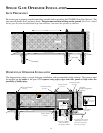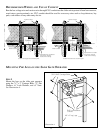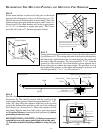
2
IMPORTANT SAFETY INSTRUCTIONS
FOR THE SYSTEM DESIGNER
WARNING: To reduce the risk of injury or death:
1. READ AND FOLLOW ALL INSTRUCTIONS.
2. This operator is intended for use only on vehicular gates. Pedestrians must be supplied with a separate
walk-through gate (see Entrapment Protection on page 6).
3. When designing a system that will be entered from a highway or main thoroughfare, make sure the system
is placed far enough from the road to prevent traffic congestion.
FOR THE INSTALLER
WARNING-To reduce the risk of injury or death:
I. Before Installation
1. READ AND FOLLOW ALL INSTRUCTIONS.
2. Verify this operator is proper for the type and size of gate, and its frequency of use.
3. Make sure the gate has been properly installed and slides freely in both directions. Repair or replace all
worn or damaged gate hardware prior to installation. A freely moving gate will require less force to operate
and will enhance the performance of the operator and safety devices used with the system.
4. All openings of a horizontal slide gate must be guarded or screened to prevent a 2
1
/4 inch diameter sphere
from passing through openings anywhere in the gate. This screen (or guard) must also be installed over the
portion of adjacent fence that the gate covers in the open position (see page 6).
5. Review the operation of the system and become familiar with its safety features. Understand how to
disconnect the operator chain with the quick release pins for manual operation of the gate (see page 1).
6. This gate operator is intended for vehicular gates ONLY. A separate entrance or gate must be installed for
pedestrian use (see page 6). NO ONE SHOULD CROSS THE PATH OF A MOVING GATE.
II. During Installation
1. Install the gate operator on the inside of the property and fence line. DO NOT install an operator on the
outside of the gate where the public has access to it.
2. Be careful with moving parts and avoid close proximity to areas where fingers or hands could be
pinched.
3. Determine the best obstruction sensing setting for this installation. The gate MUST stop and reverse on
contact with an obstruction or when an object activates the non-contact sensors. After adjusting the force
or the limit of travel, retest the gate operator. Failure to adjust and retest the gate operator properly
increases the risk of injury or death.
4. Additional safety equipment such as roller guards and safety edges (or photoelectric sensors) MUST
be installed to prevent bodily injury (see page 6).



